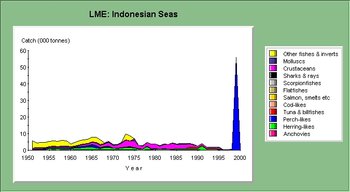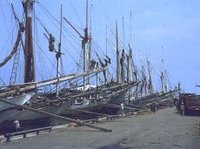Indonesian Sea large marine ecosystem
Contents
- 1 Introduction Location of the Indonesian Sea Large Marine Ecosystem. (Source: NOAA (Indonesian Sea large marine ecosystem) )
- 2 Productivity
- 3 Fish and Fisheries
- 4 Pollution and Ecosystem Health
- 5 Socioeconomics
- 6 Governance
- 7 References
- 7.1 Articles and LME VolumesFAO, 2003. Trends in oceanic captures and clustering of large marine ecosystems - 2 studies based on the FAO capture database. FAO (Indonesian Sea large marine ecosystem) fisheries technical paper 435. 71 pages. * Kadri, A.H., Mokhtar, M.B., Awaluddin, A. B. and S. Mustafa, 1999. Borneo’s Marine Ecosystem and the Greenhouse Risk Factor: A National Perspective. In: Large Marine Ecosystems of the Pacific Rim. K. Sherman and Q. Tang, Editors. Cambridge, MA: Blackwell Science, p. 438-441. ISBN: 0632043369 * Morgan, Joseph. 1989. Large marine ecosystems in the Pacific Ocean. In K. Sherman, L.M. Alexander, and B.D. Gold, eds. Biomass Yields and Geography of Large Marine Ecosystems. AAAS Selected Symposium 111. Westview Press. Boulder CO. 377-394. ISBN: 0813378443 * Zijlstra, Jenne J. and Martien A. Baars. 1990. Productivity and fisheries potential of the Banda Sea ecosystem. In K. Sherman, L.M. Alexander, and B.D. Gold, eds. Large Marine Ecosystems: Patterns, Processes and Yields. AAAS Press, Washington, DC. 54-65. ISBN: 0871683849
- 7.2 Other References
- 7.3 Citation
Introduction Location of the Indonesian Sea Large Marine Ecosystem. (Source: NOAA (Indonesian Sea large marine ecosystem) )
The Indonesian Sea Large Marine Ecosystem (LME) is a tropical LME of about 400,000 square kilometers (km2) situated at the confluence of the Pacific and Indian Oceans. It has a composite structure of environmental conditions, with local areas of upwelling, strong wind-driven and tidal currents, and nutrient inputs from rivers or human activities. The LME is influenced by a monsoonal system, with a pattern of surface currents varying during the southeast and northwest monsoon. It experiences annual and interannual variations in surface temperature. The warm ocean and its links to the atmosphere (Atmosphere layers) create the El Niño Southern Oscillation (ENSO) phenomenon. LME book chapters and articles include Morgan, 1989, Zijlstra and Baars, 1990, and Kadri et al, 1999.
Productivity
 (Source: NOAA)
(Source: NOAA) The Indonesian Sea LME extends in an east/west direction across a distance of 5,000 km. Geologically, it lies at the confluence of three tectonic plates: the Eurasian Plate, the Indo-Australian Plate and the Pacific Plate. There are numerous islands, active volcanoes and earthquake occurrences. For a map of the eastern Banda Sea and the northern Arafura Sea, indicating geomorphology and isobaths, see Zijlstra and Baars, 1990, page 55. The LME has complex ocean-atmospheric (Atmosphere layers) dynamics. For a map of surface current patterns during the southeast and northwest monsoon and for the locations of areas of upwelling and downwelling during both periods, see Wyrtki (1958), and Zijlstra and Baars, 1990, p. 56. The influence of El Niño, La Niña and the Australian and Asian monsoons contribute to the unique climate conditions in this region, an object of global climatology research. For more information on Borneo’s Marine Ecosystem and the Greenhouse (Greenhouse effect) Risk Factor, see Kadri et al, 1999. The Indonesian Sea LME is considered a Class II, moderately high (150-300 grams of carbon per square meter per year) productivity ecosystem based on SeaWiFS global primary productivity estimates. The Banda Sea, and the Aru Basin in particular, are areas of extensive upwelling. For locations of upwelling during both monsoons, see Zijlstra and Baars, 1990. Nutrient concentrations are influenced by ocean mixing and sea surface [[temperature]s]. The sea water exchange between the Pacific and Indian Oceans impacts seasonal cycles of primary and secondary marine productivity. For more information on the plankton system, see Zijlstra and Baars, 1990. Pelagic fish resources appear to be significantly higher during periods of seasonal upwelling.
Fish and Fisheries
 LME: Indonesian Seas. (Source: NOAA)
LME: Indonesian Seas. (Source: NOAA) Fish species harvested in this LME are giant gouramy, common carp, milk fish, tilapia, tuna, skipjack tuna, barramundi, anchovy, travelly, mackerel, garfish, shrimp, thumb nail (parrotfish), octopus, squid, crab, and lobster. Black marlin is a highly mobile species, fished recreation ally. The coral reef environment harbors all kinds of reef fish. Ornamental fish species are harvested and exported to the United States, Japan and Germany. These include the clownfish (Amphiprion), damselfish (Dascyllus), and wrasse (Coris gaimardi). Pearl oysters, tortoises and turtles, as well as exotic species (Alien species) of crabs and mollusks living both in salt and fresh water, are found in this LME. There are marked changes in the abundance, activity and composition of almost all components of the pelagic system of the Banda Sea, related to the monsoon-induced alternation between periods of upwelling and downwelling (see Zijlstra and Baars, 1990). However, the Food and Agriculture Organization (FAO) 10-year trend shows a steady increase of the total catch (see FAO, 2003), from 1.1 million tons in 1990, to 1.6 million tons in 1999. There is a high catch percentage for clupeoids (herrings, sardines and anchovies) (23%), coastal fishes, crustaceans, molluscs and demersal fishes. For more information on micronekton and fish, see Zijlstra and Baars, 1990. The Central Research Institute for Fisheries (CRIFI) is under the Indonesian Ministry of Agriculture. The University of British Columbia Fisheries Center has detailed fish catch statistics for this LME. For a portrayal of the data, see the graph above.
Pollution and Ecosystem Health
The fishing practices for commercial shrimp harvesting are harmful to endangered (IUCN Red List Criteria for Endangered) sea turtles that are vulnerable to retention in shrimp trawls as bycatch. Artisanal fishing and aquaculture appear to have less harmful effects. Not much is known about the status of the ecosystem in regards to pollution or coastal habitat alteration. Apart from fisheries, a major ecosystem issue is urban expansion and industrialization along the thousands of miles of coastline of the Philippines archipelago. This has resulted in water pollution from industrial wastes, sewage problems, and air pollution. Oil spills, slowly degrading toxic wastes from chemical and non-chemical industries, agricultural runoff and the dumping of materials such as metals threaten inland and coastal waters. Toxic materials settle into sea-floor sediments where they accumulate as hazards to living organisms that feed on bottom mud. Long-lasting chemicals may enter the food web and contaminate fish and shellfish. There are threats to the reefs and mangroves. For information on ozone depletion and the greenhouse (Greenhouse effect) risk, see Kadri et al, 1999.
Socioeconomics
 (Source: NOAA)
(Source: NOAA) Populations of different ethnicity, religions and languages border the LME. Economic development and a major population increase are occurring in this coastal country with thousands of islands scattered across an extensive area. The climatic fluctuations within the Asian-Australian monsoon region have important implications for the society and the economy. Indonesian waters play a major role, providing food resources for millions of people, as well as a mode of transportation and area of exploration and production of minerals and natural gas. The coastline areas are sites for industrial and other economic activities. Ports of importance are Ujung Pandang, Kalianget, Surabaya, Jakarta, Arjuna, Cirebon, Tegal and Semarang. Tourism is an important economic activity. UNESCO is funding projects on the socio-economic development of communities.
Governance
The LME is governed by Indonesia and by the recently independent state of East Timor. When Indonesia obtained its independence it enacted laws to govern the seas in accordance with its unique geographic structure as an archipelagic state. In Law of the Sea negotiations it has to balance the need to allow freedom of trade and international passage through straits with the need to protect its thousands of kilometers of coasts from potential pollution threats. The Indonesian government has declared its commitment to sustainable development by ratifying a number of conventions and formulating programs and projects that aim to defend and conserve the environment, taking into account the needs of the next generation. It has established national marine parks at Laut Banda (1977), Bunaken (1991), and Taluk Cendrawa (1990). Endangered species needing protection are the giant clam, the hawksbill turtle, the green turtle, and dugongs. Indonesia is party to conventions on Biodiversity, Climate Change, Desertification, Endangered Species, Hazardous Wastes, Law of the Sea, Nuclear Test Ban, Ozone Layer Protection, Ship Pollution, Tropical Timber 83, Tropical Timber 94, and Wetlands.
References
Articles and LME VolumesFAO, 2003. Trends in oceanic captures and clustering of large marine ecosystems - 2 studies based on the FAO capture database. FAO (Indonesian Sea large marine ecosystem) fisheries technical paper 435. 71 pages. * Kadri, A.H., Mokhtar, M.B., Awaluddin, A. B. and S. Mustafa, 1999. Borneo’s Marine Ecosystem and the Greenhouse Risk Factor: A National Perspective. In: Large Marine Ecosystems of the Pacific Rim. K. Sherman and Q. Tang, Editors. Cambridge, MA: Blackwell Science, p. 438-441. ISBN: 0632043369 * Morgan, Joseph. 1989. Large marine ecosystems in the Pacific Ocean. In K. Sherman, L.M. Alexander, and B.D. Gold, eds. Biomass Yields and Geography of Large Marine Ecosystems. AAAS Selected Symposium 111. Westview Press. Boulder CO. 377-394. ISBN: 0813378443 * Zijlstra, Jenne J. and Martien A. Baars. 1990. Productivity and fisheries potential of the Banda Sea ecosystem. In K. Sherman, L.M. Alexander, and B.D. Gold, eds. Large Marine Ecosystems: Patterns, Processes and Yields. AAAS Press, Washington, DC. 54-65. ISBN: 0871683849
Other References
- Dalzell, P., and Pauly, D. 1990. Assessment of the fish resources of southeast Asia, with emphasis on the Banda and Arafura Seas, Indonesia. Proc. Snellius-II Symp., Neth J. Sea Res. 26.
- GEF/UNDP/IMO, 1997. Pollution Prevention and Management in the East Asian Seas—a Paradigm Shift in Concept, Approach and Methodology. Regional Programme for the Prevention and Management of Marine Pollution in the East Asian Seas. 45 p.
- Moore, T.S., J. Marra, and A. Alkatiri. Response of the Banda Sea to the Southeast Monsoon. Marine Ecology Progress Series.
- NOAA. 1991. Report of the ad hoc Committee on Large Marine Ecosystems. NOAA Technical Memorandum NMFS-F/NEC-92, 19p.
- UNDP, 1991. Regional Programme for the Prevention and Management of Marine Pollution in the East Asian Seas. 9 p.
- UNESCO, 1995. Proceedings of the Coral Reef Evaluation Workshop, Pulau Seribu (11-20 September 1995), Study No. 10, UNESCO Jakarta Office.
- Wyrtki, K., 1958. The water exchange between the Pacific and the Indian Oceans in relation to upwelling processes. Proc. 9th Pacific Sci. Congr. 16:61-66.
| Disclaimer: This article is taken wholly from, or contains information that was originally published by, the National Oceanic and Atmospheric Administration (NOAA). Topic editors and authors for the Encyclopedia of Earth may have edited its content or added new information. The use of information from the National Oceanic and Atmospheric Administration (NOAA) should not be construed as support for or endorsement by that organization for any new information added by EoE personnel, or for any editing of the original content. |